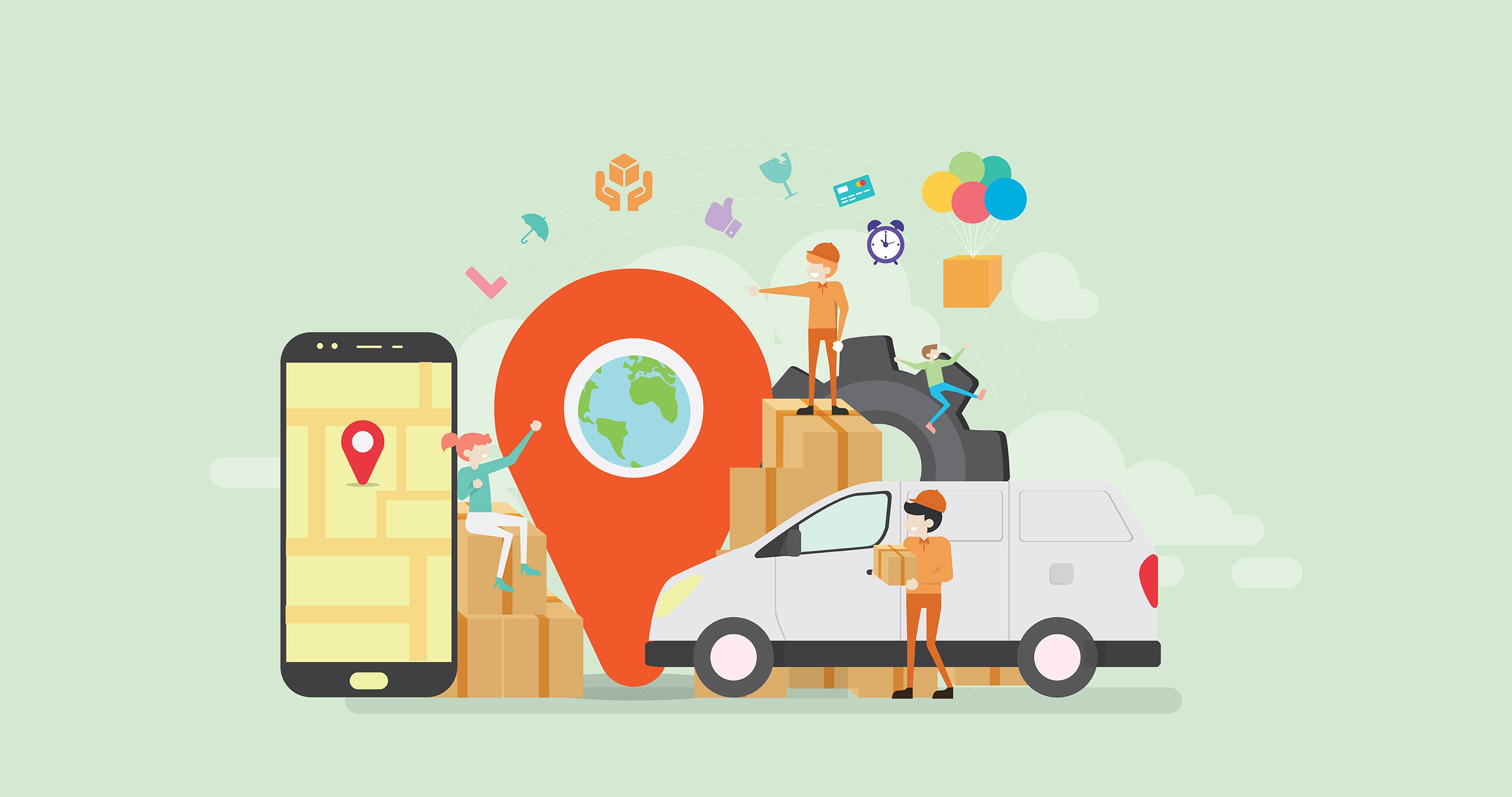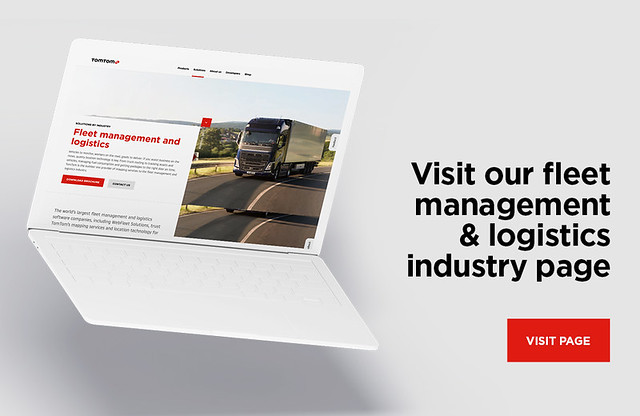5 Ways to Use Location Technology in Logistics
)

Logistics is often thought of as planes, trains, and freight trucks, but any company or organization that moves things or people from one place to another is involved in logistics. We’ll examine five innovative ways developers can use TomTom mapping APIs and SDKs to provide more effective planning, visualization, insights, and information in the field of logistics.
Logistics is often thought of as planes, trains, and freight trucks, but any company or organization that moves things or people from one place to another is involved in logistics.
These movements generate time and location data that, when analyzed with related data to the movement such as sales information or stock levels, can provide valuable insights and information that are sure to improve the effectiveness of any enterprise.
We’ll examine five ways developers can use TomTom location data to provide more effective planning, visualization, insights, and information in the field of logistics.
1. Sales and Marketing
In sales and marketing, customer location is a key demographic to track. Understanding your customer base allows you to better sell your products for them. Setting up heat maps using the TomTom Maps SDK for Web to show their locations, and then drop in some map markers to show where your offices or distribution centers are located will help you find gaps in your service before a competitor does.
Try the sample here for Clustering techniques to help determine where you should locate resources such as fire departments or service centers to provide even coverage across a city. These techniques can also help you to map sales territories or plan new offices.
As a developer you’ll likely have customer addresses from historical sales data as well as current sales leads available to you. Use the TomTom Search API and Extended Search API geocoding feature to convert street addresses into geographical points, then plot these using Map Markers as coordinates alongside those of your warehouse, sales or distribution outlets.
You may be able to predict future customer behavior or new markets based on geographical analysis of historic sales data, or where your advertising and marketing efforts can best be utilized.
To get you started quickly, don’t miss the many functional examples TomTom has provided including the heat map example. Use Geocoding from TomTom’s Search API along with the TomTom Maps SDK for Web to create a new Sales and Marketing Dashboard for your enterprise.
2. Optimizing transportation
The traditional role of logistics is to optimize transportation, to make your planes, trains, and freight trucks work more efficiently. Done well, this can pay huge dividends with up to 12 times greater profit levels than companies with less sophisticated solutions, according to studies cited by Capacity LLC.
By using the TomTom Routing API and traffic analysis you’ll be provided optimum routing. Taken to the next level, this can be coupled with real-time updates to drivers and transport operators, dynamically factoring in updates to traffic or changed delivery requirements without the need for manual intervention.
Going green? Then your routing of electric vehicles is made even easier by using TomTom’s Extended Routing API since you can calculate the reachable service range for your EV fleet. The long distance EV Routing can factor in charge points along a route based upon the vehicles consumption and charging model.
Whether it is to determine an optimum delivery strategy or plotting how to best direct your sales people, you could start with the tutorial on TomTom Developer’s Blog entitled "Using Traffic Data with Maps and Routes".
Next, look at the TomTom Geofencing API and this example code, then move to the more advanced Taxi dispatcher application sample application.
3. Reverse Logistics
“Reverse logistics” deals with optimizing the return of a product. This practice includes planning for and tracking exchange, repair, or refund during the product lifetime. It also includes managing waste disposal or recycling at the end of life of the product.
Mapping, using TomTom Routing API and traffic analysis, can help you make cost effective plans for handling goods by utilizing return trips to return stock or to help efficiently direct service personnel if on site repairs are needed.
Analysis of historic transport routing and management of assets to perform network modelling can help improve future route planning. TomTom’s Location History API can help here by allowing you to track the location of a vehicle, a person, a package, or a telephone.
Tracking the location of objects can also be simplified by using Mapcodes. These are a free, open way to make every house or location on earth addressable by a short code as opposed to a traditional address — say, when addresses are not available. Mapcodes are also easier to remember than geographical coordinates, open source, not restricted to a given vendor they help people relate to places without complicated numbers. See the article and example code here on TomTom’s Developer blog.
Youtube4. Location, Tracking, and Management of Assets
Mapping provides a way to visualize the location of assets. Used alone or with a data grid or table, maps are a powerful way to see relative location of objects to, say a central warehouse, or to other objects or people.
If your problem involves tracking assets or protection of assets from theft, then look at the new TomTom Location History API and particularly the TomTom Geofencing API, which can alert you when your assets move outside their designated area of operation. TomTom has also provided some great examples for iOS and Android to get you moving forward quickly and easily.
Developers with access to sales data and warehouse stock allocations could link this data to real-time location data of products as they are picked and packed, and GPS data from forklifts and trucks. Preset geofences can automatically monitor stock movements and ensure there are minimal stock losses.
5. Supply Chain Management, Warehouse, and Operations Planning
Supply chain managers traditionally work with spreadsheets of raw data, and may have analytical tools available for data mining and reporting. But they don't usually have experience using the kinds of mapping tools that provide the end-to-end views that could help mitigate risk and assist management make sound decisions.
Create your dashboard map objects using the TomTom Maps SDK for Web with data from raw material sourcing, delivery and storage, production, warehousing of the finished product, to delivery to retail outlets and customers. Each of these data flows can appear on your map in a similar way as you would show road traffic flows. In fact, some of the routes may actually be road traffic flows. You can also utilize the static route sample by simply altering the route width in the code, for a given segment according to the resource flow.
Mapping can help optimize the planning for new transport, warehouse, and storage decisions or updates to existing strategies. Planning new service delivery outlets or servicing centers based on customer demand versus traffic patterns can be achieved using heat maps to indicate existing hot spots of customer activity vs product availability and overlaying this with your end to end dashboard data.

Conclusion
There are many ways in which a developer can help to make an enterprise more profitable or more effective. These need not be expensive, can often use existing data sources available within the organization and using TomTom’s mapping API, a free API key should get you enough ‘mileage’ to create demonstrations that get your idea up and running with management support.
Here are some further links to articles with further information for some of the topics covered:
Get your free TomTom API key here.
Look here for more documentation and tools from TomTom
For sales and marketing, be sure to check this blog article for many good tips and pointers including issues of privacy and GDPR that should be considered.
For Reverse Logistics read the excellent article here by the Logistics Bureau.
Route optimization, reverse logistics, and comprehensive mapping tools can be game-changers when trying to provide the best service for your customers and your company. If you're looking for ways to help your customers stand out from the competition, get in touch with us to find out more. Read more about our fleet & logistics products and contact us for a free consultation here.